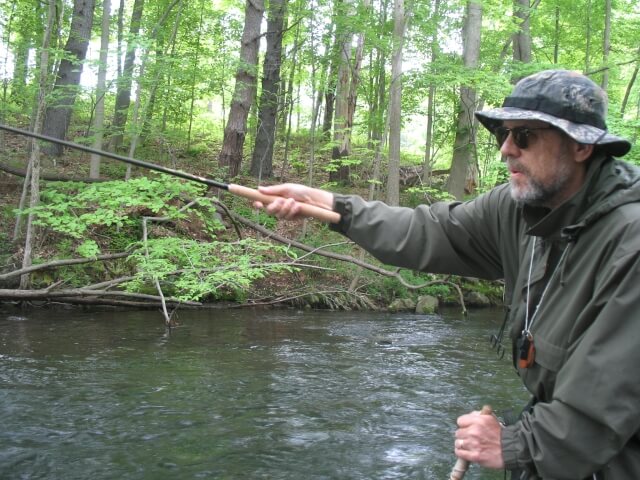Fishing in Valsesia: Fly fishing or Tenkara fishing?
It is said that fishing in Valsesia is a guaranteed extraordinary experience ... perhaps it’s because of the variety of the territory, the beauty of the valley or the many nature reserves? The melt waters of the glacier Sesia on Monte Rosa, joins those of its tributaries on the way down to the valley, creating a most unique river for all water sports. Blades, waterfalls, gorges and soft depressions alternate fishing routes, leaving you breathless and supplying fishermen corners of pristine nature, immersed in silence broken only by the sound of water.
Fly fishing reserves are spread over all the valleys of Valsesia: Varallo, Scopello, the touristic feature "High Sesia Valley", the Piode Reserve, Torrent Egua and Torrent Sermenza. Each with their own references and specific rates. The waters are home to several species: "From Alagna to Quarona the Marble trout and Brown trout are the dominant species. Marble trout and its hybrids as well as Brown trout are found from Riva Valdobbia and their presence progressively increases downstream. The presence of Rainbow trout is significant, but that of Brook trout is sporadic. The Grayling, exclusive to the Po valley is widespread in the stretch between Campertogno and Varallo. For many years this breed of fish has been subjected to a careful policy of protection and repopulation by the Valsesian Sport Fishermen Society.”
In addition there are numerous, fast flowing, tributary streams in smaller valleys creating a concert of gurgling sounds to the joy of the local fauna. For those who loved the cozy austerity of the mountains, there are mountain lakes from 2000 to 3000 meters above sea level, where Brown trout and Brook char can be found, and where only the mountain tops and those who have made it there, reflect in the deep, calm waters.
In Alagna we propose 2 different packages for fishing enthusiasts. We have specifically created the following offers:
1) Fly fishing on the river Sesia: marble trout, grayling from the Po breed, brown trout and rainbow trout for a superb fishing trip!
2) Fishing week end on the river Sesia A weekend of Fishing on the Sesia river and two days of relaxation in the reserves of Alagna and Piode.
Some interesting facts aboutfly fishing
Fishing in Valsesia: the technique of Valsesian fly fishing
This technique is the fishing tradition in Valsesia. It requires a perfect understanding of fisherman with nature, the seasons and the territory. "Valsesian fly fishing" is a world in which fishermen take care of and study every detail regarding seasons, the hatching of the insects, the color and transparency of the water to create silks of various colors and bird feathers and choosing insects better suited to attract the prey.
Fishing in Valsesia: the Valsesian technique vs the Tenkara technique
The Tenkara fishing technique and Valsesian technique have many points in common and are therefore very similar as both use the same rod type as well as fishing lines and flies.
It's a really interesting fact that these techniques were developed in two worlds so far apart, both still practiced today, are so similar. In Valsesia in 2012 the two techniques were twinned with the presence of the Master of "Tenkara fishing" Masami Sakakibara!
A brief history of Tenkara fishing and fly fishing meeting points
Fly fishing has ancient origins, born in Europe and in Japan in the first centuries BC. The flies were created using animal matter including deer antlers and bird feathers. In Japan, the first flies were used for fishing in the sea. In the EDO period (about 400 years ago), the first flies were used for fishing Ayu, "sweet fish" (Plecoglossus Altivelis). Some documents related to the sale of flies for this practice have been found. Ayu fish is found in lowland rivers while the types of fish (Amago and Iwana) caught with the Tenkara fishing technique are found in mountain streams (at 2,000 to 3,000 meters above sea level).
 The Matag
The Matag
There used to be fishing / professional hunters (Matagi) who practiced fishing in the streams. A manuscript speaking of these professional fishermen is the diary of a British consul, dating back about 120 years ago in which he describes a climb on the Japanese Alps (2992 m above sea level). The consul accompanied the fisherman Toyama Shinaemon. In it he explains that the technique used by these fishermen was fly fishing. The fishing equipment used by Toyama Shinaemon can still be seen in the Alpine museum in Nagano.
Tenkara, fly fishing and Valsesian fishing
The fundamental difference between English fly fishing and that of Tenkara is that when fly fishing a reel is used and in the Tenkara method, no. Before the invention of the reel, which dates back to the 19th century, a fixed barrel was used with the fishing line made of woven horsehair as is still used in the actual Tenkara method and that of Valsesian fishing. The Japanese fishing rods were made of various types of bamboo, strictly selected for their lightness and length. The construction technique of bamboo rods progressed significantly towards the middle of the EDO period (300 years ago) and this is documented in a number of manuscripts of the time. At that time reed plugs with their special sheaths for transportation (very similar to the sheaths of Japanese swords - Saya) already existed. The first flies used in fly fishing were the submerged type. The introduction of the use of floating flies dates back to the last 100 years of history. Floating flies were never used in the Tenkara fishing technique. Furthermore the Tenkara fishing technique was only used for subsistance fishing.

